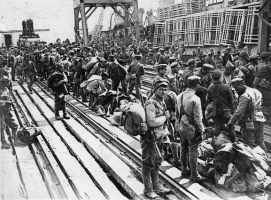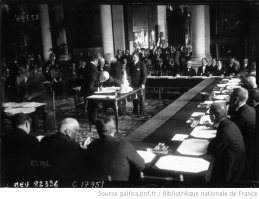Background↑
Greek Prime Minister Eleftherios Venizelos (1864-1936), who has been called the “Garibaldi of Crete” and “Cavour of Hellenism,” was an ardent Megali Idea (Great Idea) supporter after coming to power in 1910. His disagreement with the king, who favored a small but powerful Greece, led to a major political split in the country.
The Mudros Armistice on 30 October 1918 set Venizelos in motion. Between October and November 1918, he spent his time in Paris and London setting out Greece’s claims. The first occasion on which Venizelos expressed his irredentist agenda was his presentation at the Paris peace negotiations on 30 December 1918. He used the expression “unredeemed Greeks” for the Ottoman Greeks, basing his argument on statistics to prove that the Greek population was, in some regions, the majority, while also referring to the twelfth point of the Fourteen Points of President Woodrow Wilson (1856-1924). In the memorandum titled “Greece Before the Peace Congress of 1919” which Venizelos presented to the Paris Peace Conference, western Asia Minor, Thrace and the region of Constantinople were claimed. Venizelos stated: “The natural solution would be to adjudge Constantinople and its vilayet to Greece, while establishing international guarantees for the freedom of the Straits.”
The Greek Invasion/Campaign of Asia Minor↑
Italy landed troops in Antalya, and as promised in secret treaties, was waiting for Smyrna to be given to her. Regarding the wishes of Italy with doubt, France and Britain decided, as the Italians left the Council of Four, to use the already willing Greek army in order to prevent Italy from landing in Smyrna as a fait accompli. In Britain, although the troops and diplomats did not support this, Prime Minister Lloyd George (1863-1945) gave full support to the Greek occupation, recommending that the council allow Venizelos to land in Smyrna with two to three divisions “in order to protect his fellow countrymen.” On 15 May 1919, Greek soldiers landed in Smyrna with the acceptance of Georges Clemenceau (1841-1929) and Wilson.
Mustafa Kemal (1881-1938) – later known as Atatürk – who had been sent to Samsun as a military inspector, landed on 19 May 1919. There he began to organize a national resistance and gather local resistance movements around himself by assembling congresses in Erzurum and Sivas in the same year. In fact, just after the Armistice of Mudros, local congresses were formed in Asia Minor and Eastern Thrace. The Young Turks led these local organizations. They had had resistance plans against a possible occupation since the First World War. The geographic boundaries of the struggle were determined within the framework of the National Pact, adopted in the last Ottoman parliament on 28 January 1920.
This decision lead to the invasion of Istanbul by the Allies in March 1920. The assembly was disbanded, accelerating the participation of key military and civilian leaders in the Turkish National Movement in Asia Minor.
In order to prevent resistance to the severe conditions of the peace treaty being prepared, the Supreme War Council authorized a Greek offensive from Smyrna and the occupation of Eastern Thrace. Thus, from July 1920 onwards, the Greek forces started to move forward into Asia Minor. This was followed by the northern arm capturing Eskişehir and the southern arm capturing Afyonkarahisar (the sites of two major railway stations). Meanwhile, the pro-Istanbul riots that emerged in Asia Minor were a source of distress for the national movement, which had moved its center to Ankara and established a parliament. All of western Asia Minor was controlled by the Greeks, and Lloyd George's unrestricted support of the Greeks disturbed the Italians and French. This situation gave time for Ankara to recover and strengthen the army, with the help of weapons, ammunition and money from the Bolsheviks.
With the Treaty of Sèvres of 10 August 1920, Venizelos officially acquired the Aegean islands, Smyrna and its hinterland, and Eastern Thrace. However, his loss in the November 1920 elections turned everything upside down. It gave the Italians and the French the ability to rescind the promises given to the Greeks. The king's return to Greece also affected the Asia Minor Campaign. The king, who was opposed to the campaign, had to continue the operation, but did not have the same economic, military and political support that had been given to Venizelos by Britain. Moreover, it was not possible for him to tell the public to give up the apparent gains of the Sèvres Treaty.
At this point, the agreement between Ankara and the Bolsheviks changed the balance of power in the Caucasus and then in Asia Minor. Thus, the Turks shifted their Eastern Army to the west, gathering the irregular bands that had previously fought in the form of gangs under the Western Army. The command of the newly formed Western Army was passed from Ali Fuat Pasha (1882-1968), later known as Cebesoy, to İsmet Pasha (1884-1973), later known as İnönü.
Battles↑
In January 1921, upon feeling Sèvres to be in danger, the Greek army was ordered to advance. The Greek attack on 6 January 1921 was stopped with a one-day clash in İnönü, near Eskişehir. After this development, the British government decided that the Treaty of Sèvres was no longer applicable and the London Conference, to which Turks and Greeks were invited, was held from February to March 1921. Since it was understood that the Sèvres Treaty could not be realized as it was, its adjustment was intended. But these decisions were rejected by both Ankara and Athens.
The Second Battle of İnönü, which was the Greek army’s second attempt in April, ended once again with failure, and the Greek army returned to Uşak, having to retreat for the first time. In May, the Allies declared their neutrality. This meant that only Lloyd George's personal support was left behind the Greek army.
After being defeated twice, the Greek army changed its strategy. The northern part was divided in two, with the first group keeping the Turkish army occupied, while the second group united with those in the south to carry out a powerful attack on Eskişehir. However, at the end of the twenty-two-day Battle of Sakarya (23 August to 13 September 1921), General Anastasios Papoulas (1857-1935) could not pass the point that would take him to Ankara. Following a counterattack by the Turkish army, the Greek army lost 20,000 soldiers and Papoulas resigned.
Ankara’s success accelerated the process of withdrawal by the Italians from Asia Minor and France’s search for a means of reconciliation with Ankara. Indeed, in October 1921, the French withdrew from Asia Minor. This development left Britain as the only supporter of the Greek army.
As a last campaign, on 26 August 1922, the attack began with heavy artillery fire by the Turkish army. Greek Commander Nicolaos Tricoupis (1868-1956) was late in realizing that Turkish forces were concentrated in Afyonkarahisar. Greek General Athanasios Frangou's (1864-1923) troops retreated towards the west, following the railway. This group of 20,000 soldiers intended to create a defense in Dumlupınar, but the Turkish army attack did not allow this. In the Battle of Dumlupınar, between August 26 and August 30, Tricoupis' troops could not find the opportunity to unite. Frangou chose to retreat to Izmir and burn everything in his path. Meanwhile, the Greek third army in the north ordered the evacuation from Bandırma and Mudanya. The Greek army was now following a scorched-earth policy. Thus, on September 9, the Turkish army reached Smyrna.
Afterward↑
A few days after the Turkish army took control, the famous Smyrna fire, whose origins are still controversial, began on September 13. The fire affected the Christian districts the most, causing them to be destroyed or suffer great damage. Following the victory of the Turkish army on 30 August 1922, the Greek soldiers, as well as the Greeks in the occupied territories, started to flee out of fear of the Turks taking revenge. This exodus lasted for a few months. Thus, by the beginning of the Lausanne Conference in November 1922, 800,000 to 900,000 Greeks had left Asia Minor.
The Armistice of Mudanya was signed on 11 October 1922. The defeat led to a military coup in Greece, the king's exile, and the execution of certain politicians and soldiers deemed responsible for the “Asia Minor Catastrophe.” Apart from defeat, this meant the “end of Hellenism of Asia Minor”. The Treaty of Sèvres, which could not be applied, was replaced by the Treaty of Lausanne, which was signed on 24 July 1923 at the end of the Lausanne Conference.
Elçin Macar, Yıldız Teknik Üniversitesi
Section Editor: Pınar Üre
Selected Bibliography
- Atatürk, Mustafa Kemal: The great speech, Ankara 2005: Atatürk Research Center.
- Cebesoy, Ali Fuat: Millî mücadele hâtıraları, Istanbul 2000: Temel.
- Goldstein, Erik: Great Britain and Greater Greece 1917-1920, in: The Historical Journal 32/2, 1989, pp. 339-356.
- Jensen, Peter Kincaid: The Greco-Turkish war, 1920-1922, in: International Journal of Middle East Studies 10/4, 1979, pp. 553-565.
- Karabekir, Kazım: İstiklal Harbimiz, 2 volumes, Istanbul 2019: Yapı Kredi Yayınları.
- Kitromilides, Paschalis (ed.): Eleftherios Venizelos. The trials of statesmanship, Edinburgh 2006: Edinburgh University Press.
- Koliopoulos, Giannis S. / Veremis, Thanos M.: Greece. The modern sequel. From 1821 to the present, London 2007: Hurst & Company.
- Palles, Alexandros Alexandru: Greece's Anatolian venture and after, London 1937: Methuen.
- Psomiades, Harry J.: The Eastern question. The last phase. A study in Greek-Turkish diplomacy, Thessaloniki 1968: Institute for Balkan Studies.
- Smith, Michael Llewellyn: Ionian vision. Greece in Asia Minor, 1919-1922, New York 1973: St. Martin's Press.
- Tanör, Bülent: Türkiye'de Kongre İktidarları (1918-1920), Istanbul 2016: Yapı Kredi Yayınları.
- Venizelos, Eleutherios: Greece before the peace congress of 1919. A memorandum dealing with the rights of Greece, New York 1919: Oxford University Press.
- Zürcher, Erik-Jan: The unionist factor. The role of the Committee of Union and Progress in the Turkish national movement, 1905-1926, Leiden 1984: Brill.












